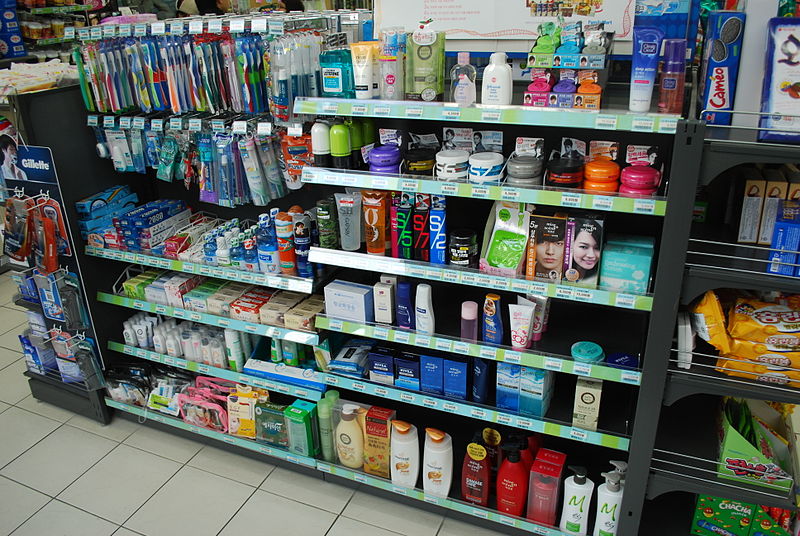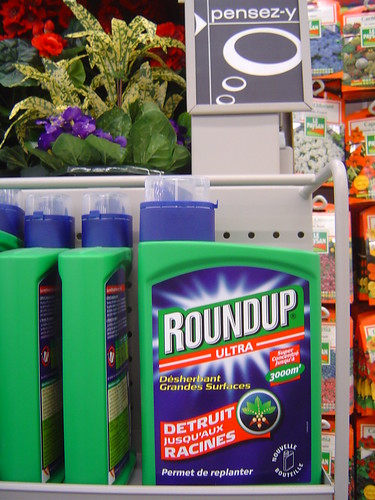Last week, the tweets were flying furiously in a "Right to Know" campaign regarding fem care products (for more information, see here). Apparently, there's concern over the fact that feminine hygiene products are not labelled, we do not know what's in them, and that may include GMO cotton. Two "experiments" were performed:
 |
| Every item here is potentially toxic Wikipedia Commons |
2) Two tampons were submerged in ultra-purified water on someone's kitchen table: one was O.B and one was organic cotton. The O.B tampon supposedly released a lot more fibers, which are assumed to be rayon, and the O.B tampon also developed spots, which are assumed to be mold.
Based on these experiments, there's a petition to Procter & Gamble to disclose the make up of their fem care products.
The concern is that the contents of the fem care products will leach into our systems, since "our skin is the largest and most absorbent organ in our body" (that's from Dr Mercola's site, highlighting the dangers of inorganic fem care products).
I'll begin with the fact that there's no evidence for the causation or even association between synthetic fem care products and health issues. Let me outline the steps I took:
- I checked Snopes.com for any information on tampons and pads. There are two false urban legends regarding tampons being associated with toxic shock syndrome, as well as the presence of asbestos in tampons. There is also a false urban legend regarding the use of sanitary pads being linked to cases of uterine and bladder cancer.
- I went to pubmed and typed in "feminine hygiene products". I found 1337 hits. That's not a typo. 1337 various studies have been carried out examining different aspects of feminine hygiene products ranging from their use in HPV detection, HIV prevention, and health education. Study methods range from the examination for irritation with new film surfaces to the analysis of changes in bacterial cultures with feminine care products.
- I checked the American Cancer Society's webpage, which stated that the link between tampons and cancer is "absurd". I searched on the American Medical Association's webpage, and couldn't find anything.
- After that, I stopped.
With 1337 studies performed, the alleged toxicity of fem care products is not an issue to our doctors or to the FDA. Instead of speculating that it's due to payoffs from big corporations like P&G or Unilever, I will propose that it's because it's not a problem.
There are several issues at hand. One is that the team or individual behind this whole movement has not done their homework. If I was able to find this information during my lunch break at work, then so could they. This is perhaps best highlighted by the fact that O.B tampons are not made by P&G and that their petition on change.org is to the incorrect person. As to the burning of the products, I hate to say it but that experiment is up there with putting salt water fish in fresh water to see if they'll die. Always products contain glue, plastic liners, and other oil-based compounds which anyone would expect to burn differently from an organic cotton pad. As for the mold, if you look at the pictures those brown specs are present even at 2 hours. But even at 24 hours, the likelihood that it's mold is pretty low, and it's probably just cotton fibers.
Second is that if you are going to argue that toxins from GMOs and from hygenic products leach into your system through your skin, here's a list of items that you should be aware of:
- The cotton clothes you wear are probably made of GM cotton
- The natural baby care products may contain ingredients from GM crops.
- The fabric in your car and child's car seat might contain GM cotton
- The production of many types of fabrics and plastics require alcohol, which might be ethanol made from GM corn or soybeans
- Your wool clothes might be from animals that are fed GM alfalfa
- Your leather furniture might be from animals that are given GM feed
- The taxi that you take might be running on ethanol gas from GM corn, as well as the municipal vehicles in your area. All that GM DNA might be in the air...
And then there's all those toxins from all the other things that come into contact with your skin and how they might impact your health:
- Your cell phone cover is in your hand or in your pocket for most of the day, and probably contains "toxins" that make the plastic durable and robust
- The mouse on your computer has a rubber wheel, which may contain natural rubber from a farm that douses its trees with pesticides
- Your desk and table are probably made of composite wood that release tons of formaldehyde that you're breathing and is entering your pores
- and a million different things
There is no evidence that any of this is true. In the past, I've shown how we might create a sharknado or a zombie apocalypse, in similar hypothetical statements. At this point, we're beyond sharknados. We're at sharktopi (is that the plural of a sharktopus?).
My next point is regarding your "right to know". I am willing to bet Baby-Boy's two chubby cheeks that in the highly unlikely scenario that P&G responds to your request, the list of ingredients in their feminine care products will include compounds with words like "poly-X" or "ethyl-Y" or "nitro-Z" and you will be displeased because they won't sound "natural". Someone out there will do a bit of research and will probably discover that those compounds are also present in other ominous things like trash bags or the sole of your shoes, and you will panic. So instead of making a ruckus and trying to get a giant corporation to disclose trade secrets which they are not legally obliged to provide, why don't you just buy organic fem care products and be done with it?
Finally, the video with the fem care product bonfire was put together by a company that sells "100% natural fem care products". So isn't there a possibility that you're being duped by a company that's trying to sell their product into believing that there's an issue when there really isn't one?
I'd like to close with a personal note. My sister, the mother of two phenomenal kids, is a chemical engineer and has been working for P&G for over 5 years. She started as an intern and has worked with them in two different countries, so I've met a few of her friends and colleagues. And she worked in their fem care product lines. I've always felt that the mark of a good product is brand loyalty, especially from its own employees. And I have never seen a company with employees as loyal to their products as P&G, with the possible exceptions of Google and Apple. So if you think that they put products out there without proper testing, you're wrong. If you think they'd create products that would knowingly endanger you, you're outta whack.
I've said this before and I'll say it again: yes, big corporations (correction: ALL corporations including companies that make "100% natural tampons") are in the business of making money and to create a crummy product or a product that would be recalled would not be conducive to their goals.
